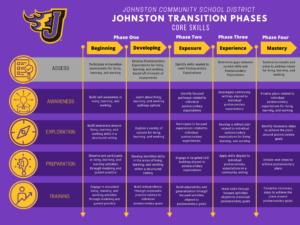Johnston Transition – Core Matrix
The Transition Core Matrix (see below) was developed by the Johnston Community School District. The matrix outlines the Johnston Transition Phases and serves as a roadmap for developing essential transition skills for students. It is based on the Iowa Transition Model and the Career Connected Learning model, both of which emphasize structured pathways to help students plan for life beyond high school.
The matrix is divided into five core skill areas—Assess, Awareness, Exploration, Preparation, and Training—and spans five progressive phases:
- Beginning
- Developing
- Experience
- Exposure
- Mastery
Each phase builds on the previous one, illustrating how students move from gaining initial awareness and engaging in guided practice to applying skills in real-world settings and finalizing postsecondary plans. The purpose is to guide students, educators, and families in understanding and supporting the development of transition skills for living, learning, and working.
This structured progression allows for tailored planning to meet students’ individual needs and to set and achieve meaningful postsecondary goals. Whether through assessing skills, building awareness, or engaging in targeted training, the matrix provides a comprehensive framework for preparing students for successful adult life.
Johnston Transition Skills – Core Skills
| Beginning | Developing | Exposure | Experience | Mastery | |
| Assess | Participate in transition assessments for living, learning, and working | Develop Postsecondary Expectations for living, learning, and working based off of results of assessments | Identify skills needed to meet Postsecondary Expectations | Determine gaps between current skills and Postsecondary expectations | Summarize results and plans to address needs for living, learning, and working |
| Awareness | Build self-awareness in living, learning, and working | Learn about living, learning, and working pathway options. | Identify focused pathways related to individual postsecondary expectations | Investigate community settings aligned to individual postsecondary expectations | Finalize plans related to individual postsecondary expectations for living, learning, and working |
| Exploration | Build awareness around living, learning, and working skills in a structured setting. | Explore a variety of options for living, learning, and working. | Participate in focused experiences related to individual postsecondary expectations | Develop a refined plan related to individual postsecondary expectations for living, learning, and working | Identify necessary steps to achieve the plans around postsecondary goals |
| Preparation | Observe and participate in living, learning, and working activities through modeling and guided practice. | Develop identified skills in the areas of living, learning, and working within a structured setting. | Engage in targeted skill building aligned to postsecondary expectations | Apply skills aligned to individual postsecondary expectations in a community setting | Initiate next steps to achieve postsecondary plans |
| Training | Engage in simulated living, learning, and working activities through modeling and guided practice | Build independence through purposeful practice related to individual postsecondary goals. | Build adaptability and generalization through focused activities aligned to postsecondary goals | Hone skills through focused activities aligned to individual postsecondary goals | Complete necessary steps to achieve plans around postsecondary goals. |
